1、 Breeding environment
1. Soil: rose flowers like fertile and moist soil. It is best to choose loose sandy loam with good drainage
2. Temperature: the suitable temperature for the growth of rose is 18-20 ℃. If the temperature reaches 25 ℃, its growth will accelerate, but the flowering period will become shorter; When the temperature reaches 30 ℃, the flowers are not only small, but also prone to diseases and pests; If the temperature is lower than 5 ℃, it will enter a dormant state and stop growing
3. Light: the rose can grow better only when there is enough sunlight. Give it at least 5-6 hours of light every day. If the light is too weak, it will grow in vain or the color of the flower will fade. Appropriate shading measures should be taken at noon in summer
4. Watering: when new branches and leaves grow, they should be watered once every two days. When buds appear, they should be watered once every day. During flowering, they should be watered once in the morning. The soil should not be too dry or too wet. In summer, you can often spray water on the leaves to cool down

2、 Breeding method
1. Cutting propagation: generally, cutting is carried out in spring or early autumn. The plant shall be peeled first, and then the branches shall be cut off for cutting after callus is produced
2. Sowing and reproduction: the spacing of sowing is generally 3 cm. After sowing, it is covered with a layer of sand and watered with water. The seedlings can emerge in about 40 days

3、 Common pests
1. Aphids: Black secretions appear after being harmed. Imidacloprid and avermectin can be used alternately during its oviposition
2. Leaf bee: there will be holes in the leaves, and in serious cases, the tender will be slightly gnawed away. Spray with medicine when pests occur


 how many times do yo...
how many times do yo... how many planted tre...
how many planted tre... how many pine trees ...
how many pine trees ... how many pecan trees...
how many pecan trees... how many plants comp...
how many plants comp... how many plants can ...
how many plants can ... how many plants and ...
how many plants and ... how many pepper plan...
how many pepper plan...































